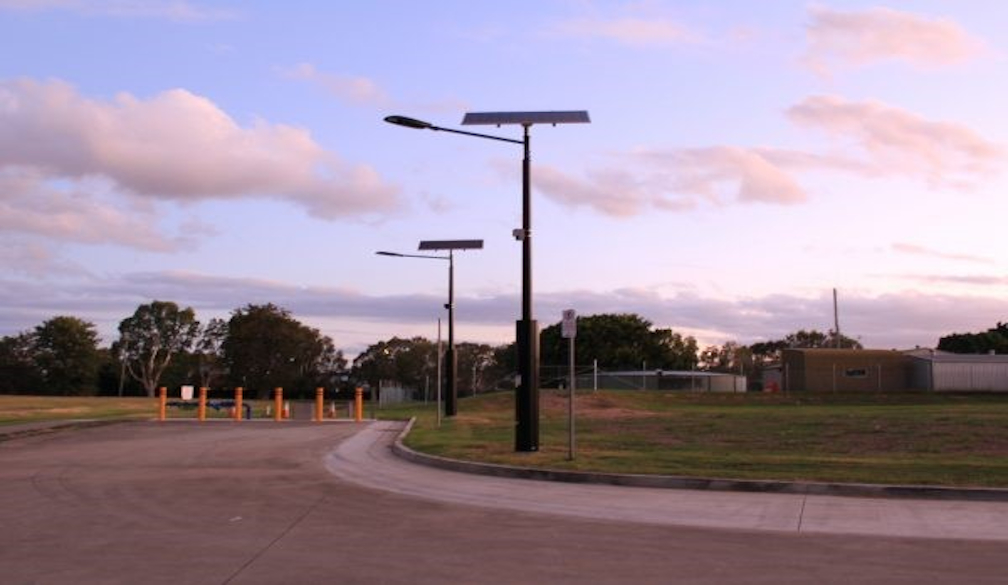Brightening Streets sustainably: How Solar Street Lights Are Revolutionizing Urban Landscapes

In an era of increasing urbanization and the urgent need to address climate change, finding sustainable solutions to meet our energy demands is crucial. Australia, known for its abundant sunshine, is now harnessing the power of solar energy to revolutionize its urban landscapes. Solar
street lights are emerging as a game-changer in illuminating streets while reducing carbon emissions and energy costs. This article explores the benefits and potential of solar street lights and their impact on Australian cities.
How Do Solar Street Lights Work?
Solar street lights utilize photovoltaic (PV) panels to convert sunlight into electricity. These panels are mounted on the street light pole, absorbing sunlight during the day and storing energy in batteries for nighttime use. Integrated sensors automatically switch on the lights at dusk and off at
dawn, ensuring efficient energy usage.
Why Are Solar Street Lights Sustainable?
Solar street lights offer a range of sustainable advantages over traditional grid-powered street lights:
Reduced Carbon Emissions: Solar street lights significantly reduce carbon emissions by relying on clean energy. According to the Australian Solar Council, a single solar street light can save approximately 370 kilograms of CO2 emissions annually compared to conventional street lights[^1^].
By transitioning to solar lighting systems, Australia can make substantial progress toward its climate targets.
Energy Independence: Solar street lights operate independently of the electrical grid, reducing dependence on fossil fuels. This decentralization strengthens the resilience of the lighting infrastructure and ensures uninterrupted lighting even during power outages.
Lower Operational Costs: While the initial installation costs of solar street lights may be higher than conventional lighting systems, the long-term operational costs are significantly lower. Solar street lights require minimal maintenance, as they have fewer components and do not rely on grid
electricity. The savings in electricity bills can be redirected to other essential services.
Brightening Australian Streets with Solar Power
Enhancing Safety and Security: Adequate street lighting is essential for public safety and crime prevention. Solar street lights provide reliable illumination, creating safer environments for pedestrians, cyclists, and motorists. Studies have shown that well-lit streets can deter criminal
activities and improve road safety.
Expanding Accessibility: Solar street lights play a vital role in enhancing accessibility in remote areas and areas with limited electrical infrastructure. By utilizing solar energy, communities can illuminate their streets and public spaces without the need for expensive grid connections.
Promoting Renewable Energy Adoption: The installation of solar street lights showcases a visible commitment to renewable energy. It raises awareness and encourages communities, businesses, and individuals to explore other sustainable energy solutions, such as rooftop solar installations and energy-efficient practices.
Solar Street Lights in Australian Cities
Adelaide: Adelaide, the capital of South Australia, has embraced solar street lights to enhance its sustainability credentials. With over 40,000 solar-powered street lights installed across the city, Adelaide has become a leading example of utilizing clean energy for urban lighting[^2^]. The initiative has not only reduced energy costs but also contributed to the city's target of becoming carbon neutral by 2025.
Brisbane: Brisbane, the capital of Queensland, has recognized the potential of solar street lights in transforming its urban landscape. The City Council has embarked on a project to replace 5,000 conventional street lights with solar-powered alternatives. This transition aims to reduce the city's carbon emissions and create a more energy-efficient lighting system.
Melbourne: Melbourne, the vibrant capital of Victoria, has also embarked on solar street lighting projects. The installation of solar-powered street lights in public spaces, parks, and major thoroughfares aligns with the city's commitment to sustainable urban development. By adopting solar technology, Melbourne is enhancing its reputation as a leading eco-friendly city.
Overcoming Challenges and Promoting Adoption
While solar street lights offer numerous benefits, their widespread adoption in Australian cities does face certain challenges. These challenges include initial installation costs, public perception, and technical considerations. However, with the right strategies and support, these challenges can be
overcome to accelerate the deployment of solar street lights.
Cost Considerations: The initial cost of installing solar street lights can be higher compared to conventional lighting systems. However, it is important to consider the long-term cost savings associated with lower energy consumption and reduced maintenance requirements. Additionally, advancements in solar technology and economies of scale are driving down the overall costs, making solar street lights increasingly affordable.
Public Perception and Awareness: Educating the public about the benefits of solar street lights is crucial for their acceptance and support. Providing information on the environmental advantages, cost savings, and improved safety can help dispel misconceptions and build public trust. Awareness
campaigns and community engagement programs can play a vital role in promoting the adoption of solar street lights.
Technical Considerations: Effective planning and design are essential for successful implementation. Factors such as shading, positioning of solar panels, battery capacity, and light distribution need to be carefully considered. Collaborating with experts in the field can ensure optimal performance and maximize the benefits of solar street lighting systems.
A Roadmap for Solar Street Lighting Implementation
To accelerate the adoption of solar street lights in Australian cities, the following steps can be taken:
Policy Support: Governments at the national, state, and local levels should develop supportive policies and incentives to encourage the installation of solar street lights. This can include grants, subsidies, and streamlined regulations to facilitate the transition to solar lighting.
Collaboration and Partnerships: Collaboration between government agencies, lighting manufacturers, and energy experts is essential to drive innovation, share best practices, and develop standardized guidelines for solar street lighting installations. Partnerships with community organizations and local businesses can also enhance public engagement and funding opportunities.
Demonstration Projects: Implementing pilot projects in selected areas can demonstrate the feasibility and benefits of solar street lights. These projects can serve as showcases and help build confidence among decision-makers and the public.
Capacity Building: Providing training and capacity-building programs for installers, maintenance personnel, and local communities can ensure the effective operation and maintenance of solar street lighting systems. This can contribute to job creation and foster local expertise in renewable
energy technologies.
The Economic Benefits of Solar Street Lights
Apart from their sustainability advantages, solar street lights also offer significant economic benefits for Australian cities.
Long-Term Cost Savings: Solar street lights provide substantial long-term cost savings compared to conventional grid-powered lights. Once installed, solar street lights operate using free and renewable solar energy, eliminating electricity bills and reducing operational costs. The savings can
be redirected to other critical infrastructure projects or public services.
Job Creation: The widespread deployment of solar street lights can contribute to job creation and stimulate local economies. The installation, maintenance, and monitoring of solar lighting systems require skilled professionals, providing employment opportunities in the renewable energy sector. According to the Clean Energy Council, the solar industry employs over 26,000 Australians1.
Reduced Electricity Demand: Solar street lights reduce the demand for electricity from the grid. By utilizing solar energy, cities can alleviate the strain on the electrical infrastructure, especially during peak hours. This can potentially lead to lower electricity prices and a more reliable grid for both
residential and commercial consumers.
Supporting the Renewable Energy Sector: The adoption of solar street lights contributes to the growth of the renewable energy sector in Australia. Increased demand for solar panels, batteries, and associated equipment stimulates the manufacturing, distribution, and installation industries. This fosters innovation, drives technological advancements, and positions Australia as a global leader in renewable energy solutions.
Scaling Up Solar Street Lighting in Australia
To fully realize the potential of solar street lights and accelerate their deployment across Australia, several strategies can be implemented:
National Solar Street Lighting Program: A coordinated national program that provides funding, guidelines, and technical assistance for the installation of solar street lights can facilitate their widespread adoption. Such a program can leverage economies of scale, reduce costs, and streamline the implementation process.
Public-Private Partnerships: Collaborations between government entities, private companies, and financial institutions can drive the expansion of solar street lighting projects. Public-private partnerships can leverage expertise, share costs, and accelerate the deployment of solar lighting systems in urban and regional areas.
Integration with Smart City Initiatives: Solar street lights can be integrated with smart city technologies to optimize energy use and enhance functionality. By incorporating features such as motion sensors, dimming capabilities, and remote monitoring, cities can achieve further energy
savings and improve operational efficiency.
Community Engagement and Education: Engaging communities and raising awareness about the benefits of solar street lights are crucial for their acceptance and support. Public information campaigns, community consultations, and educational programs can help build trust, address concerns, and encourage community participation in solar lighting projects.
Solar street lights are transforming urban landscapes in Australia, providing sustainable, energy-efficient, and cost-effective lighting solutions. With their ability to reduce carbon emissions, enhance safety, and promote renewable energy adoption, solar street lights have the potential to revolutionize street lighting systems across the country. Overcoming challenges and promoting widespread adoption requires policy support, public awareness, technical expertise, and collaboration. By embracing solar street lights, Australian cities can lead the way in creating greener, more resilient, and vibrant urban environments.



